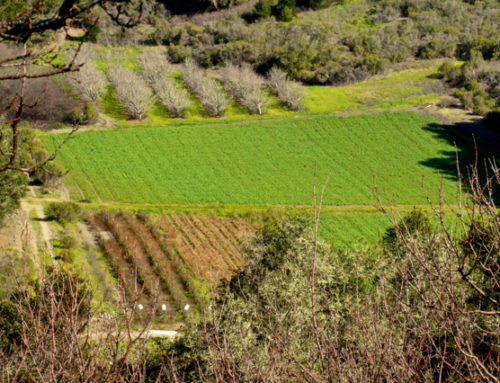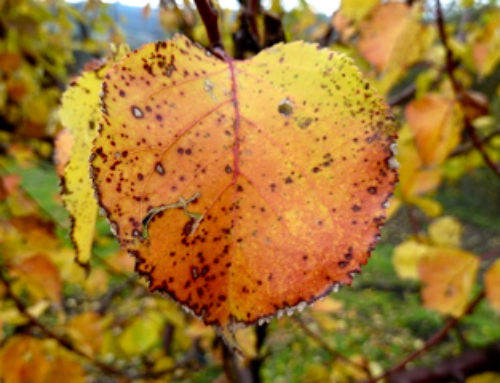 Eating with the seasons teaches us patience. Tomatoes may be available whenever I might want at the store, but few things give me greater pleasure than waiting for that special moment in the season when I can harvest and bite into a sun-warmed, vine-ripened, dry-farmed tomato. Although “dry-farming” sounds ordinary, it is actually the culmination of a complex “dance” between farmer and nature. Dry-farming tomatoes is a technique perfected a couple of decades ago by Molino Creek, a farming cooperative situated in the coastal hills above Davenport. We are fortunate to enjoy a similar microclimate. Dry-farming techniques involve proper spacing, soil moisture control, timely cultivation practices, soil rotation and a number of different fertility practices. Under optimum conditions the plants, although stressed from a lack of water, will stay healthy enough to yield, in my opinion, one of the best tasting red tomatoes out there.
Eating with the seasons teaches us patience. Tomatoes may be available whenever I might want at the store, but few things give me greater pleasure than waiting for that special moment in the season when I can harvest and bite into a sun-warmed, vine-ripened, dry-farmed tomato. Although “dry-farming” sounds ordinary, it is actually the culmination of a complex “dance” between farmer and nature. Dry-farming tomatoes is a technique perfected a couple of decades ago by Molino Creek, a farming cooperative situated in the coastal hills above Davenport. We are fortunate to enjoy a similar microclimate. Dry-farming techniques involve proper spacing, soil moisture control, timely cultivation practices, soil rotation and a number of different fertility practices. Under optimum conditions the plants, although stressed from a lack of water, will stay healthy enough to yield, in my opinion, one of the best tasting red tomatoes out there.
“Early Girl” is the variety of choice for dry-farming; it is one of the very few tomato varieties (possibly the only one) that can be dry-farmed. Bred in France in the 1970’s they became an instant hit when they arrived in the United States and today still rank as one of the most popular tomato varieties, especially among gardeners. Tomatoes are not of European origin, quite the contrary; their ancestry can be traced to the impenetrable jungles of Central and South America. The Mayans called it “xtomatl” hence the name tomato. When the Spanish brought the first tomato to Europe it was given the name “pomodoro” (golden apple) and cursed to be poisonous, like some of its relatives in the nightshade family. It was given the botanical name lycopersicum, which means “wolf peach.” The Church condemned eating tomatoes as a scandalous and sinful indulgence and banned it. On the other hand, the French admired its sensuous appearance and were enticed by it, believing that the red fruit had aphrodisiac powers, and so called it “pomme d’amour” or love apple. Not until the 1800s did the tomato finally gain broad culinary acceptance in Europe. Today, we probably couldn’t imagine anything more scandalous than not having tomatoes as part of our diet.
The crop of tomatoes we are now harvesting was sown in a greenhouse in mid-January and transplanted in the field in March. It takes us over 6 months from planting the seed to finally harvesting the first tomatoes. To extend our harvest into the fall, we add two additional tomato plantings staggered 3 and 6 weeks apart. This is true for many of the 50 or so crops we grow every year; many are planted in succession. Timing, plus adjusting to the variables for each successive crop, is what makes our way of farming uniquely challenging. Successional plantings need to fit natural variables such as soil moisture, temperature, and day length, and synchronize with the timing, field rotations and unique growing habits of each crop variety. Although we are only just starting to harvest our summer bounty of crops, we are already well underway in sowing and planting of fall and winter crops: our winter squash was field sown in June, and will take 100-120 days to mature, so they should be ready sometime in early October; fall and winter leeks were sown in the greenhouse in May and transplanted into the field end of July; other fall crops ready to be planted include the beautiful Romanesco cauliflower, Brussels sprouts and Cabbage. And course popular winter root crops such as parsnips, rutabaga and celeriac (celery root) are being sown now so they have enough time to size up before short cold days stop their growth.
 In addition to being patient and flexible regarding “what’s in the box,” CSA members are often asked to be open to trying new types of vegetables. A couple of years ago, for example, we experimented with a new pepper variety – the Padron pepper, and were rewarded with a tasty discovery. Now they have become a staple in our annual production, and will be in the shares with regularity. When my family had this season’s first roasted Padron Peppers a couple of weeks ago, the kitchen filled with that familiar, tantalizing aroma and everyone came to the table with a smile in anticipation of this yummy treat. Even Elisa munched on them, as if the threat of biting into a hot one was of no concern.
In addition to being patient and flexible regarding “what’s in the box,” CSA members are often asked to be open to trying new types of vegetables. A couple of years ago, for example, we experimented with a new pepper variety – the Padron pepper, and were rewarded with a tasty discovery. Now they have become a staple in our annual production, and will be in the shares with regularity. When my family had this season’s first roasted Padron Peppers a couple of weeks ago, the kitchen filled with that familiar, tantalizing aroma and everyone came to the table with a smile in anticipation of this yummy treat. Even Elisa munched on them, as if the threat of biting into a hot one was of no concern.
No one has written a more poetic and humorous story about these Padrons than our neighbor-farmer Andy Griffin, of Mariquita Farm. If you love these peppers as much as I do then you owe it to yourself to read his story, “Pardon my Padróns.” Andy is always one-up on his fellow organic growers when it comes to experimenting with and selecting unusual and great tasting vegetable varieties. So thanks to Andy, and subsequent requests by CSA members and farmer’s market customers, we started growing “Chiles de Padron.” The Padrons are said to have been brought to Spain from Mexico by Franciscan monks in the 16th century, where they were then adapted to the soils and climate of Galicia near the town of Padron, after which the Peppers are named. The town of Padron is located near the Atlantic coast, where today they are grown extensively in a climate probably very similar to ours. The people of Padron best describe the character of these peppers in their native Galician as “Os pementos de Padron, uns pican e outros non.” (Padron peppers, some are hot and some are not.) Indeed, eating Padron peppers is likened to playing Russian Roulette — you never know which one you bite into will be burning hot. Debbie offered to include her description of how they are best prepared. So enjoy, but don’t forget to have something close by to cool your palate should you encounter a hot one!





